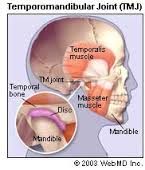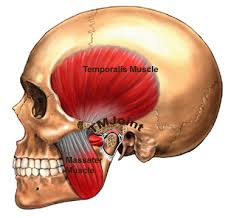What is a Temporomandibular Joint (TMJ)?

TMJ: Temporomandibular joint is the hinge joint that connects the lower jaw to the temporal bone, which is immediately in front of the ear on each side of your head. The joints are flexible, allowing the jaw to move smoothly up and down and side to side. The joints helps you to talk, yawn and chew during eating. Muscles around the joint control the movement and positioning of the jaw.
TMD: Temporomandibular disorder refers to a condition that is often painful affecting the joint and muscles that assist in moving the jaw and neck. Most of the time the pain goes away with little or no treatment. Discomfort from TMD is usually temporary.
What Causes TMD?
 Trauma such as from a heavy blow or whiplash can cause this disorder by injuring the jaw, TMJ or muscles of the head and neck. Other possible causes include grinding, clenching your teeth and dislocation of the disc between the ball and socket. Osteoarthritis (OA), degenerative joint disease (DJD), malalignment, rheumatoid arthritis (RA), stress, postural deficits (forward head) and poor breathing may also cause TMD.
Trauma such as from a heavy blow or whiplash can cause this disorder by injuring the jaw, TMJ or muscles of the head and neck. Other possible causes include grinding, clenching your teeth and dislocation of the disc between the ball and socket. Osteoarthritis (OA), degenerative joint disease (DJD), malalignment, rheumatoid arthritis (RA), stress, postural deficits (forward head) and poor breathing may also cause TMD.
What Are the Symptoms of TMD?
- Headache and dizziness.
- Ear pain, ringing in the ears and hearing loss. Often mistaken for an ear problem such as an ear infection.
- Pain and tenderness in facial muscles, jaw area, neck and shoulders.
- Painful clicking, popping or grating sounds in the jaw when opening or closing mouth.
- Limited mouth opening and closing, “getting stuck” or locking.
- Difficulty chewing, eating or talking.
How Is TMD Diagnosed?
Your dentist conducts a physical history and exam to determine the cause of symptoms. Tests such as X-rays, EMG (analyzes the electrical activity of the muscles in your jaw at rest and during function), CT scans and MRI will not only assist in diagnosing but also in treatment of a patient.
Treatments:
Conservative treatment includes anti inflammatory medications. Splinting such as occlusal mouth guards and Cortisone may also help.
Treatments in Physical Therapy include: Soft tissue mobilization, joint mobilization, therapeutic exercises, Modalities such as Heat, Ultrasound, E-Stimulation, Light therapy and Postural education.
Your Physical Therapist will also provide you with a Home Exercise Program that may include the following:
- Controlled opening
- Rhythmic stabilization
- Shoulder/scapular stabilization
- Axial neck extension
- Stabilized head flexion
- Proper breathing techniques and
- Postural education.

